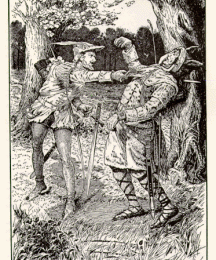
Guy of Gisborne is a perennial villain in the Robin Hood tradition. He first appears in the medieval / early modern ballad "Robin Hood and Guy of Gisborne," dated to the final quarter of the fifteenth century. His most notable medieval characteristic is his unusual costume: he wears a complete horsehide – top, tail, and mane – as a form of armor. Robin takes the armor and dresses as Guy, mutilating the corpse's face and then carrying his victim's severed head to the Sheriff. Despite this (initial) gruesome end, Guy reappears consistently in the many iterations of the Robin Hood tradition. In the early tradition he is a bounty hunter, hired by the Sheriff to track down and kill Robin. In the modern era of film and television, however, Guy is the Sheriff's second in command. Guy's competence varies from text to text, particularly in the modern iterations of the character, and is dependent upon the tone of the production of as a whole. In order to provide Robin Hood with a credible villain in the Sheriff, Guy is often set up as the comic relief; alternately, if the Sheriff is an incompetent buffoon, Guy is takes the role of sinister power behind the throne.
Robin Hood and Guy of Gisborne - 1997 (Editor)
Robin Hood's Birth, Breeding, Valour, and Marriage - 1997 (Editor)
Robin Hood's Birth, Breeding, Valour, and Marriage - 1997 (Editor)
Robin Hood and Guy of Gisborne - 1997 (Editor)
Robin Hood's Birth, Breeding, Valour, and Marriage - 1997 (Editor)
Robin Hood's Birth, Breeding, Valour, and Marriage - 1997 (Editor)
F. W. Fairholt (c. 1813 - 1866)
Charlotte Harding (1873 - 1951)
Howard Pyle (1853 - 1911)
Louis Rhead (1857 - 1926)
F. W. Fairholt (c. 1813 - 1866)

Charlotte Harding (1873 - 1951)

Howard Pyle (1853 - 1911)

Louis Rhead (1857 - 1926)













